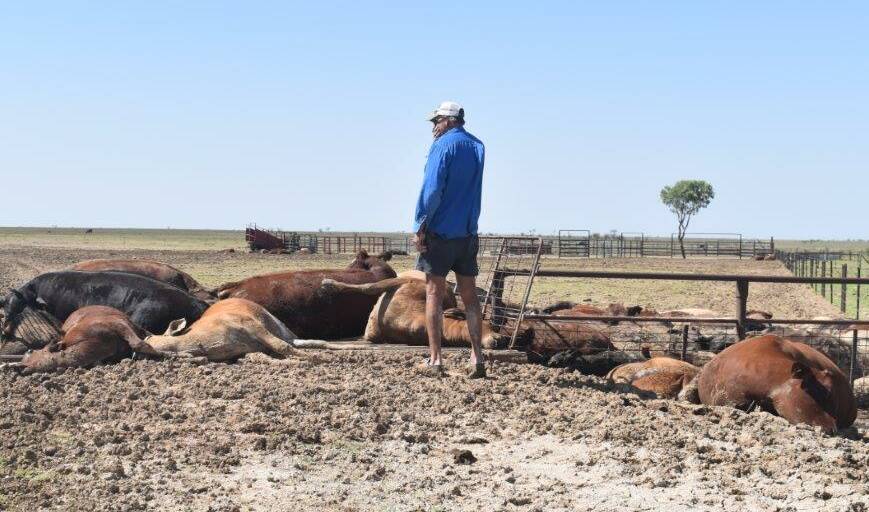
As the cleanup after northern Queensland’s exceptional February flood gains momentum, the Australian Agricultural Company is also tallying up the cost of extremely dry and hot conditions in southern Queensland and Northern Territory.
Extra drought fodder, transport and feeding routine expenses are likely to cost AACo about $57 million this financial year.
The drought bill shows few signs of easing despite the big deluge further north in the Gulf of Carpentaria.
The big beef business has estimated a least 42,000 cattle - more than half the grown cattle herd on its four Gulf country properties - died during the flood.
Flood's damage toll
Across approximately 800,000 hectares of affected properties the infrastructure damage bill alone for repairs to property, plant, fencing, and water equipment was estimated to total $6 million to $8m.
Dry conditions and extreme heat have significantly impacted the company’s cost of production, and operating expenses will continue to increase
- Australian Agricultural Company
The stations, Wondoola, Canobie, Dalgonally and Carrum, had a combined herd of about 82,000 prior to two weeks of torrential rain setting in early last month.
Early assessments suggest up to 90 per cent of Wondoola’s big 33,000 herd, plus calves, have been lost.
The 2500 square kilometre station, about 140 kilometres south of Normanton, was evacuated at the height of the flooding as water swirled up to the eaves of some buildings.
However, managing director, Hugh Killen, has reported to the Australian Securities Exchange overall livestock losses were actually lower than initial expectations in some cases.
More surviving cattle were also likely to be identified as mustering by AACo staff and neighbours began in earnest.
The massive flooding event had seen cattle distributed over great distances away from the defined property boundaries of all cattle station operations in the region.
A complete assessment of cattle numbers will occur as mustering by AACo and our neighbouring properties is undertaken over coming months
- Hugh Killen, AACo
Tens of thousands of kilometers of boundary fences across the Gulf were estimated to have been destroyed.
“It will be some months before these are fully repaired,” Mr Killen said.
“Therefore, a complete assessment of cattle numbers will occur as mustering by AACo and our neighbouring properties is undertaken over coming months.”

But, while Gulf country flood levels had now largely receded, the continued impact of the widespread drought conditions hitting much of eastern and central Australia meant AACo was juggling two very different herd management challenges.
Drought costs rise
Ongoing extreme seasonal conditions in south-western Queensland and the Barkly Tableland in the Northern Territory would significantly increase station operating expenses, particularly grain, feeding and transport costs.
“The dry conditions and extreme heat have significantly impacted the company’s cost of production, and operating expenses will continue to increase with further deterioration in the season,” the company said in its ASX statement.
It pointed to AACo’s half-year results announced in November had identified additional first half-year operational expenses of $28.5m, compared with the same period in 2017.
RELATED READING:
“The second half is expected to be substantially in line with that trend,” said AACo, Australia's largest beef producer.
“AACo remains fully committed to its current strategy and continues to benefit from a robust balance sheet with our overall financial position remaining strong.”
However, while the wet and dry conditions were impacting on AACo’s current herd, the seasonal challenges would not affect the company’s ability to fulfill supply obligations to its branded beef customers.
Branded beef supply
Nor was it disrupting AACo’s branded beef strategy rollout efforts, with new deals involving high end customers currently being locked down.
Mr Killen said all animals intended for the company’s premium branded beef supply chain were already in feedlots.
“Today’s update provides further clarification consistent to and within the scope of the preliminary estimates in our initial advice to the market,” he said.
While the cattle losses sustained by all pastoralists in the impacted area, were tragic, we are now turning our full attention to recovery and ensuring a long-term, resilient and sustainable future for the beef industry in the Gulf
- Hugh Killen, AACo
“On-the-ground assessments remain ongoing and it will be some time before we have a complete evaluation of the full impact of the flooding event.
“The speed, scale and extent of this natural disaster was unprecedented in the region and the impact on the local community and industry in the Gulf cannot be underestimated.
“While the cattle losses sustained by AACo, as all other pastoralists in the impacted area, were tragic, we are now turning our full attention to recovery and ensuring a long-term, resilient and sustainable future for the beef industry in the Gulf.”
A further update would be provided in the company’s full-year results, to be released in May.
- Does this article interest you? Scroll down to the comments section and start the conversation. You only need to sign up once and create a profile in the Disqus comment management system for permanent access to all discussions.


